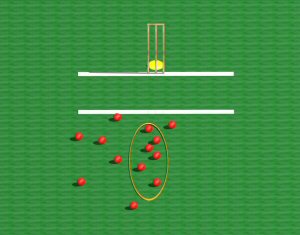Office
+44 (0) 1954 231 494
Cambridge Ultrasonics
Cambridge, UK
Consultancy service in physics, electronics, maths & ultrasonics

Cambridge Ultrasonics
Menu

When a cricket ball bounces it generates sound and ultrasonic waves that travel out into the ground as spherically expanding wavefronts. The yellow objects are sensors that record the arrival time of the waves and from the time-differences the position of the bounce can be calculated.

Red balls show where the ball hit the ground. The yellow ellipse is the sweet-spot for the bowler. Results show that the bowler has achieved good length grouping but too many balls are drifting wide.
Sport applications
Feasibility - spinning cricket balls
A good example of feasibility testing done by Cambridge Ultrasonics was in sport. A client wanted to know can ultrasound in air be used to detect the spin on a cricket ball? It is difficult to detect spin on a perfectly smooth rotating sphere (rotating about an axis passing through the centre of the sphere) because a perfect reflection obtained from a perfectly smooth surface does not sample the spin. However, with a rough ball, like a cricket ball (particularly the seam), there are many edges that can scatter ultrasound so detecting spin with a rough ball is easier. Feasibility was demonstrated experimentally for spin detection but with an interesting twist. The effect of spin was to cause a Doppler shift in the frequency of the scattered ultrasound; the interesting feature was that the cricket ball produced a range of Doppler shifts, not one single shift in frequency, showing that it was the component of the linear velocity of the rotating surface of the ball (parallel to the ultrasonic beam direction) and not the angular velocity that caused the Doppler shift. The linear velocity component varies with the angle between the axis of rotation of the ball, the direction of the ultrasonic beam impinging on the ball and where on the ball the wave arrives (the azimuth angle to the spin axis). Because the ultrasound covers all the ball, there is a range of azimuth angles between 0o and +/-90o and this causes a variation in linear velocity. The variation of linear velocities results in a range of Doppler shifted frequencies.
Where does the cricket ball bounce?
Still on the subject of cricket, Cambridge Ultrasonics was approached by a cricket club. Can ultrasound be used to help train bowlers and batsmen? This project set us thinking. One way it might help bowlers would be to detect where on the wicket (grass) the ball bounces after the bowler has released it. Most bowlers have a sweet-spot area on the wicket, depending on the type of bowling, and want to get 90% of their deliveries in the sweet-spot. For example, fast bowlers often aim for an area in front of the off-stump or just outside it with a good length but aiming to have the ball bouncing ahead of the bat and lifting by the time it reaches the batsmen to the height of the top of the bat. The idea is to get an outside edge from the bat and for the slip-fielders to catch the ball and get the batsmen out.
We proposed a system comprising a lap-top computer with a USB dongle that could communicate with 4 sensors by wireless. The sensors would be the size of a cricket ball or smaller on a short spike about 100 mm long. The spikes would be pushed into the ground around the wicket and would detect sounds in the ground, in particular the sound of the ball hitting the ground. The sound travels out across the surface in a circular expanding wave-front to reach the 4 sensors at different times depending on the distance of each sensor from the place where the cricket ball bounces. Provided the sensors are synchronized, then the nearest sensor to the bounce position can be used as a reference and relative time delays calculated (by cross-correlation). From the time-delays the position of the bounce can be calculated if the positions of the sensors are known and the speed of sound in the ground is known - the latter can be found by a calibration experiment. We calculated all the mathematics and thought through the system design and proved it was feasible.